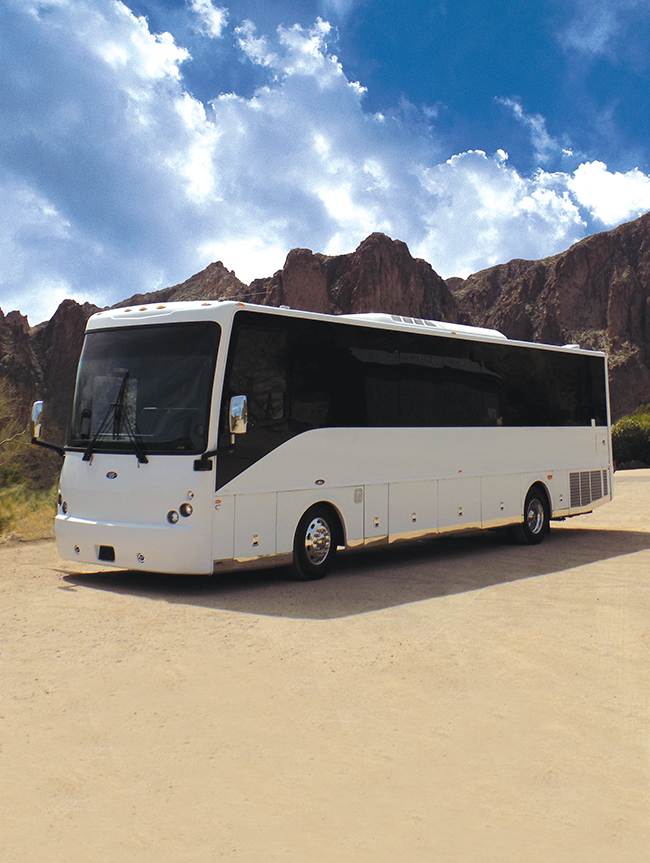
By Richard Tackett
The path toward the CT Coachworks passenger coach began when husband and wife team Steve and Susan Thomas founded Wolverine Fabricating, Inc. in 1992 as a fabricator of luggage doors. Eventually they grew their company to a business with multi-million-dollar profits, supplying the RV industry with laminated aluminum luggage-door systems, side walls, roofs and more materials fabricated in-house.
Around the time the Thomas family sold their operation to a Fortune 500 company in 2005, Steve began dabbling in manufacturing motorhomes with his father-in-law (the founder of Fleetwood Motorhomes) under the banner of CT Coachworks. The company’s manufacturing capabilities grew to include limousines and, eventually, touring motorcoaches.
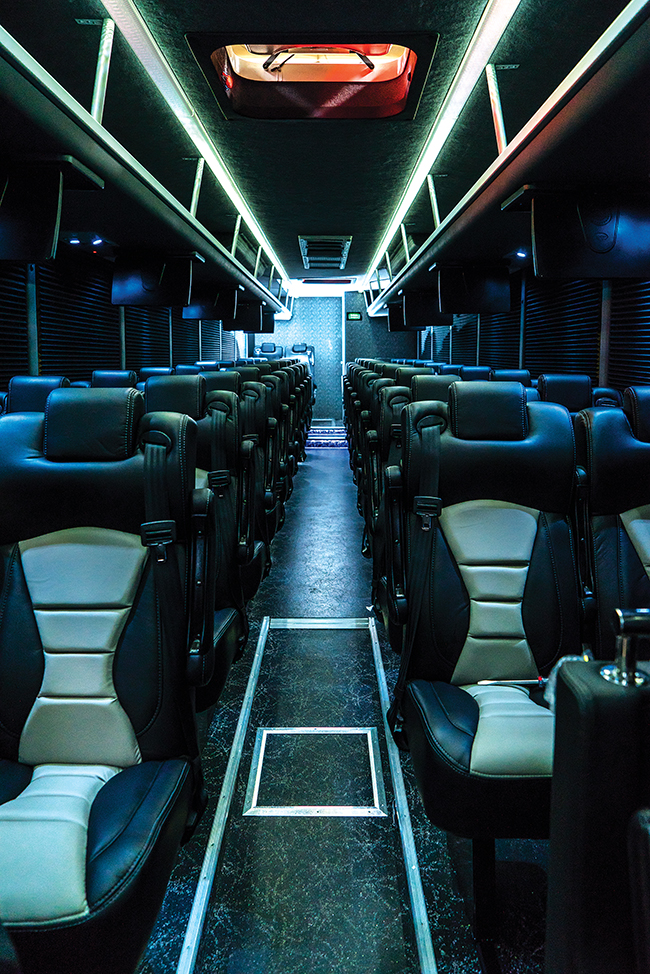 Everything in-house
Everything in-house
CT Coachwork’s Riverside, CA, facility boasts 125,000 square feet but is home to only Steve and Susan Thomas plus 11 employees. Steve says that members of his team have spent anywhere from eight to 26 years working with him, and that tight-knit bond explains their efficiency.
“We have excellent communication,” he says. “We all work together to accomplish our goals, and most importantly we know what works. We know the major pitfalls and headaches associated with manufacturing, and we know how to avoid them and keep our customers happy.”
The facility has 50 square-feet of CNC equipment; multiple benders; steel- and aluminum-pressing equipment; overhead cranes; and scales for measuring vehicle weight.
Thomas says that componentry and parts availability is another core strength of CT Coachworks.
“I always have windshields, I always have entry doors, I always have side windows,” he says. “My claim to fame is – because we’ve made 1.4 million luggage doors – if you ever need a luggage door then I’ll get it to you in one day.”
“Because we manufacture everything aside from the Freightliner chassis in-house – our own sheets, our own lamination and, of course, our own doors – it’s easy to quickly service our customers and get them what they need,” he adds.
The vehicle
CT Coachworks’ passenger coach is available in 45- and 41-foot configurations, respectively accommodating 56 or 44 passengers. Thomas and his team build on a Freightliner XBR 41’ and XBP 45’ chassis with a major modification – to strengthen the chassis and allow for more luggage storage, they remove the chassis frame rails and install extra front- and rear-support structures of heavy steel, then reinstall the frame rails.
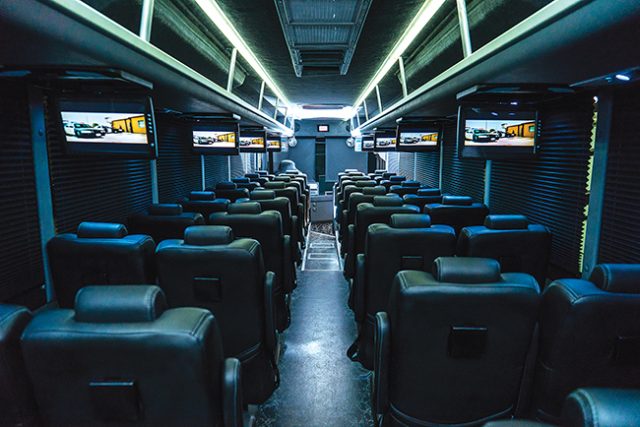
“We’ve had Freightliner inspect our modification and they are very happy with what we’ve come up with,” Thomas says. “Our welding and reinforcement process makes the frame stronger and safer.”
The coach’s standard features include:
• Cummins ISL 9.0 engine and Allison B-400 transmission
• Mobile Climate Control / Carrier Roof Mount HVAC
• ZF independent front air suspension
• Neway ADL-SD rear air suspension
• 300 cubic feet of underbelly luggage and overhead interior luggage
• 102 inches wide with 60-degree turning radius
• Three-point seat belts
• Lavatory
• Monitors, DVD, Wi-Fi, stereo and CD player
• USB and 110-V connections
CT Coachwork’s in-house building process and its small but efficient team of employees allow the company to ensure a $299,000 price point for the vehicle, making it an attractive option for coach buyers.
The vehicle’s floor is a single, sealed and vacu-bonded unit with three-pound density from 3/4-inch plywood. Extrusions interlock the floor with the sidewall, which has interlocking extrusions with the vehicle’s ceiling. Thomas says this unique feature makes for a strong but simple assembly.
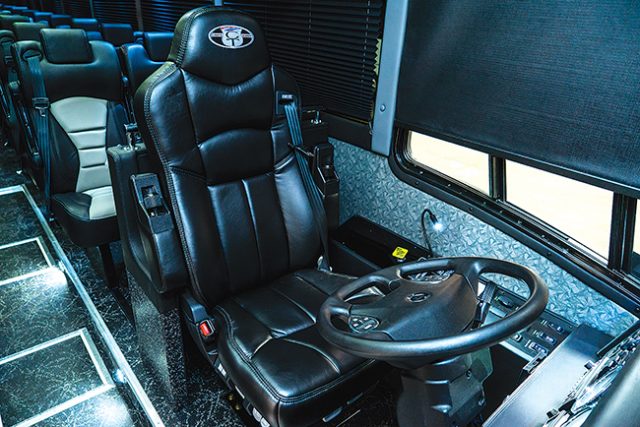
An extremely rigid ceiling is reinforced by 5.5 inches of foam insulation, also vacu-bonded. CT Coachworks crafts all interior panels by hand, ensuring there is 1/4-inch of foam padding behind each one – which Thomas says makes for a soft touch and a quiet ride. The windows and overhead luggage compartments are surrounded by vinyl rather than plastic.
CT Coachworks purchases “naked” Isringhausen driver seats and then adds the upholstery in-house. Drivers are also treated to a single-piece windshield allowing for maximum visibility, and the cockpit features a dashboard which flips up for maintenance.
“We try hard to make sure everything in the vehicle is serviceable,” Thomas says. “If a technician can’t reach an area he’s trying to work on, that means more time and more effort.”
A wide, accessible entryway welcomes passengers with handrails extending to curbside. Three tiers of indirect lighting are available – low, medium or high – and each passenger seat has its own LED light and HVAC control.
The 44-passenger vehicle test-driven for this article features nine televisions over which the driver has complete control. Thomas says he thinks that is better than each individual seat having its own screen, as operators prefer to control streaming onboard content.
The vehicle’s lavatory is one-piece fiberglass and has a 3.5-inch HVAC vent pumping air to ensure freshness.
Thomas says in-house fabrication and manufacturing allows his team to listen to customer requests. CT Coachworks, he says, prides itself on being able to accommodate requests of all sorts.
 The Official BUSRide Road Test
The Official BUSRide Road Test
For the vehicle’s test drive, BUSRide met CT Coachworks at the headquarters of All Aboard America! in Mesa, AZ.
The history of All Aboard America! dates to 1936 with the Potash Mines Transportation Company, founded by Henry Page. It merged with his daughters’ family company, Industrial Bus Lines, in 1971, creating the regional powerhouse known industry-wide today. Now led by Henry’s grandson Jack D. Wigley as president and CEO, the company has locations in Arizona, Texas and New Mexico.
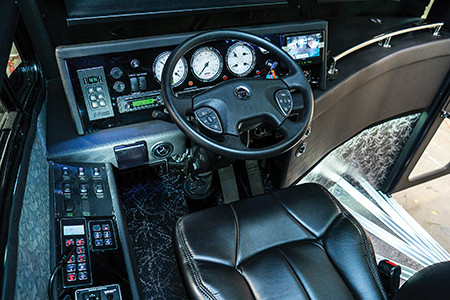 Nic Xenophontos is the corporate safety and training director for All Aboard America! A Vietnam veteran and former medic of 27 years, Xenophontos began working as a tour bus driver in 2001. He ascended to his current position in 2013, where he conducts vehicle tests and leads training at All Aboard America! safety meetings.
Nic Xenophontos is the corporate safety and training director for All Aboard America! A Vietnam veteran and former medic of 27 years, Xenophontos began working as a tour bus driver in 2001. He ascended to his current position in 2013, where he conducts vehicle tests and leads training at All Aboard America! safety meetings.
BUSRide asked Xenophontos to choose a test route for the vehicle which would gauge its performance in both urban and rural settings. He opted to first drive through the city of Mesa on a route to Sky Harbor Airport in Phoenix, testing the vehicle’s maneuverability with tight turns and in traffic.
From the airport, he drove the coach on the highway north of Phoenix toward the mountains of Tonto National Forest, aiming to see how the vehicle performed after an abrupt elevation change of about 2,000 feet. Once in that mountainous area, Xenophontos took the coach up and down hills and through desert patches, as well as on the highway to see how it handled with mountain winds.
After pulling into and out of a state park with very tight corners, Xenophontos drove the coach down a mountain pass, then back through the desert and downtown Mesa to arrive at All Aboard America! headquarters.
Immediately, Xenophontos commented on the aesthetics of the coach.
“It’s a very beautiful vehicle, both inside and out,” he said. “The seats are well laid out and the electronics are clearly high-end. The coach projects a clean, comfortable look to passengers.”
He praised the layout of the driver’s area from his perspective as a safety director.
“The biggest attraction for me, only because I’m used to traveling in other motorcoaches, is that there is a big space between the steering wheel and the front windshield – which is more common in RVs,” he said. “It helps that everything is laid out within arm’s length and I am very comfortable as I do my six-direction safety checks.”
Xenophontos said the HVAC system by Mobile Climate Control worked wonderfully, which is crucial in hot-weather locations like Phoenix.
“The climate was comfortable, and the lighting was beautiful,” he said. “The coach is very comfortable and aesthetically pleasing for passengers and drivers.”
As far as maneuvering on the roadways, he said the turning radius was tight and that he never worried about hitting a curb or any other error associated with driving a new vehicle.
“The coach handled very nicely smoothly,” he said. “The steering was very receptive, which I noticed right away.”
The vehicle stopped well in city traffic, he said, and he was impressed with the short brake-to-stop distance of a motorcoach its size.
“Responsiveness and braking are two critical factors which I look for from a safety standpoint,” he said. “This coach did very well in both areas.”
The coach, he said, accelerated nicely at green lights in the city. It took a little extra effort to accelerate in the mountain passes north of Phoenix, but that is largely a result of the incredibly steep grades found there.
Xenophontos said he focuses on safety more than any other feature of a vehicle, and he was impressed with the CT Coachworks design because of its passenger accessibility, the comfortable entryway and the responsiveness with which CT Coachworks could accommodate requests like his.
“From talking to them, it seems like they can make adjustments to many elements of the coach based on customer requests,” he said. “That’s very important when it comes to safety.”
“Overall, the coach by CT Coachworks is a nice, comfortable vehicle,” he concluded. “It will perform well on almost any highway in the United States.”
“I was drawn to the motorcoach industry because it’s so people-oriented when it comes to safety and product support,” Thomas says. “And, honestly, motorcoaches are fun to manufacture.”
Given the positive reception of its flagship vehicle by a professional like Xenophontos, it seems likely that CT Coachworks will continue to grow in renown as more operators come onboard.
For more information visit www.ctcoachworks.com or call 1-866-373-7727.
